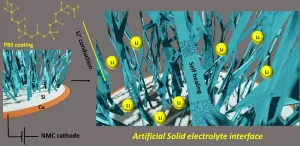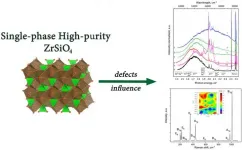(Press-News.org) Although silicon anodes could greatly boost the capacity of Li-ion batteries, their performance rapidly degrades with use. Polymeric coatings can help solve this problem, but very few studies have explored the underlying mechanisms. In a recent study, scientists from Japan Advanced Institute of Science and Technology investigate how a poly(borosiloxane) coating greatly stabilizes the capacity of silicon anodes, paving the way for better and more durable Li-ion batteries for electric cars and renewable energy harvesting.
Since their conception, lithium-ion batteries (LIBs) have been constantly improved and adapted so that they can become suitable for vastly different applications, from mobile devices and electric cars to storage units for renewable energy harvesters. In most larger-scale applications (such as the latter two), the focus of LIB research is placed on increasing their capacity and voltage limits without increasing their overall size. Of course, for that to be possible, the components and materials of the battery must be switched up.
Many researchers have placed their bets on the use of silicon anodes instead of the traditional graphite anodes. The anode is the part of the battery where lithium ions are stored when the battery is charged, which then flow through a medium called electrolyte to the cathode on the other end when the battery's charge is used. Although silicon is certainly a promising anode material that offers an almost tenfold capacity increase for LIBs, it brings with it a series of challenges that have to be overcome before silicone anodes can be commercialized.
In a recent study published in ACS Applied Energy Materials, a team of scientists from Japan Advanced Institute of Science and Technology (JAIST) tackled the problems of silicon anodes using a promising polymeric coating: poly(borosiloxane) (PBS). The study was led by Professor Noriyoshi Matsumi and also involved Dr. Sai Gourang Patnaik and Dr. Tejkiran Pindi Jayakumar, who were completing a doctoral course at JAIST at the time.
Polymeric coatings can solve one of the most serious drawbacks plaguing silicon anodes: the formation of an excessively large solid electrolyte interphase (SEI). The spontaneous formation of the SEI between the electrolyte and the anode is actually essential for the long-term performance of the battery. However, materials like silicon tend to expand greatly with use, which causes continuous SEI formation and the depletion of the available electrolyte. Needless to say, this hinders the performance of the battery and causes a massive drop in capacity over time.
This is where polymeric coatings come into play; they can prevent the excessive SEI formation on silicon and form an artificial and stable SEI (see Figure 1). Though researchers had already noted the potential of PBS as a coating for silicon anodes, previous studies did not offer clear explanations for the mechanisms at play, as Prof. Matsumi explains, "There are very few reports on well-defined PBS-based polymers that offer a mechanistic origin for their application and their effects. Thus, we wanted to evaluate and shed light on their contribution to silicon anodes as a self-healing artificial interface that also prevents detrimental volume expansion."
The team compared the short- and long-term performance of silicon anodes with and without polymeric coatings in terms of stability, capacity, and interfacial properties. They did this through a series of electrochemical measurements and theoretical calculations, which led them to understand how PBS helps stabilize the capacity of the silicon anode.
Compared to bare silicon anodes and anodes coated with poly(vinylidene fluoride) (a commercially used coating in LIBs), the self-healing properties of PBS and its reversible accommodation of lithium ions resulted in remarkably enhanced stability. This is partially due to the ability of PBS to fill in any cracks formed in the SEI during operation. As shown in Figure 2, the capacity of the PBS-coated silicon anode remained almost the same for over 300 hundred cycles, unlike that of the other two anodes.
By addressing the main issues associated with silicon anodes, this study paves the way to a new generation of LIBs with much higher capacity and durability. Satisfied with the results, Prof. Matsumi remarks, "The widespread adoption of high-capacity LIBs will allow electric cars reach longer distances, drones become larger, and renewable energy be stored more efficiently." He also adds that, within a decade, we might even see LIBs used as secondary energy sources in larger vehicles such as trains, ships, and aircrafts. Let us hope further research gets us there!
INFORMATION:
About Japan Advanced Institute of Science and Technology, Japan
Founded in 1990 in Ishikawa prefecture, the Japan Advanced Institute of Science and Technology (JAIST) was the first independent national graduate school in Japan. Now, after 30 years of steady progress, JAIST has become one of Japan's top-ranking universities. JAIST counts with multiple satellite campuses and strives to foster capable leaders with a state-of-the-art education system where diversity is key; about 40% of its alumni are international students. The university has a unique style of graduate education based on a carefully designed coursework-oriented curriculum to ensure that its students have a solid foundation on which to carry out cutting-edge research. JAIST also works closely both with local and overseas communities by promoting industry-academia collaborative research.
About Professor Noriyoshi Matsumi from Japan Advanced Institute of Science and Technology, Japan
Noriyoshi Matsumi obtained Master's and PhD degrees from Kyoto University, Japan, in 1997 and 2000, respectively. He joined JAIST in 2010, where he currently leads the Matsumi Lab at the School of Materials Science. He specializes in lithium-ion secondary batteries, metal-air batteries, electrocatalysis, solid polymer electrolytes, ionic liquids, and organoboron compounds, as well as solar cells and photoconductive materials. He has published over a hundred papers, authored 19 books, and received multiple awards from The Society of Polymer Science, Japan, and the Chemical Society of Japan.
Researchers from the Department of Infection and Immunity of the Luxembourg Institute of Health (LIH) brought forward the potential of high doses of a specific adjuvant molecule, namely CpG oligonucleotide, in successfully modulating the immune system's allergic response to the main cat allergen Fel d 1, thereby inducing a tolerance-promoting reaction and reverting the main hallmarks of cat allergy. The researchers analysed the molecular mechanisms underlying this tolerance and proposed a pre-clinical allergen-specific immunotherapy approach to improve the treatment and control of this common type of allergy. The full study results ...
Sudden cardiac arrest is more often fatal in people with COVID-19, a new study shows. Those responsible for the research see the results as a wake-up call for the public and care providers alike.
The survey now published in the
European Heart Journal is a register-based observation study. It covers all 3,026 cases of sudden cardiac arrest that were reported to the Swedish Registry for Cardiopulmonary Resuscitation in the period from 1 January to 20 July 2020 -- that is, both before and during the pandemic.
The Registry's statistics show that, in Sweden, there are 6,000 cases of sudden cardiac ...
Ozone is a problematic air pollutant that causes serious health problems. A newly developed material not only quickly and selectively indicates the presence of ozone, but also simultaneously renders the gas harmless. As reported by Chinese researchers in Angewandte Chemie, the porous "2-in-one systems" also function reliably in very humid air.
Ozone (O(3)) can cause health problems, such as difficulty breathing, lung damage, and asthma attacks. Relevant occupational safety regulations therefore limit the concentrations of ozone allowable in the workplace. Previous methods for the detection of ozone, such as those based on semiconductors, have a variety ...
Thermoelectric generators, TEGs for short, convert ambient heat into electrical power. They enable maintenance-free, environmentally friendly, and autonomous power supply of the continuously growing number of sensors and devices for the Internet of Things (IoT) and recovery of waste heat. Scientists of Karlsruhe Institute of Technology (KIT) have now developed three-dimensional component architectures based on novel, printable thermoelectric materials. This might be a milestone on the way towards use of inexpensive TEGs. The results are reported in npj Flexible Electronics (DOI: 10.1038/s41528-020-00098-1) and ACS Energy Letters (DOI: 10.1021/acsenergylett.0c02159).
"Thermoelectric generators directly convert thermal into electrical energy. This technology enables ...
The scientific novelty of the work of scientists from Ural Federal University, Institute of Solid State Chemistry and Geology and Geochemistry of the Ural Branch of the Russian Academy of Sciences lies in the fact that for the first time scientists solved the task of creating zircon with certain spectral properties. To this end, they have worked out the so-called sol-gel method.
It is distinguished by its technological simplicity, controllability of processes and allows synthesizing a larger volume of products with high purity than with other ...
Using patient data, artificial intelligence can make a 90 percent accurate assessment of whether a person will die from COVID-19 or not, according to new research at the University of Copenhagen. Body mass index (BMI), gender and high blood pressure are among the most heavily weighted factors. The research can be used to predict the number of patients in hospitals, who will need a respirator and determine who ought to be first in line for a vaccination.
Artificial intelligence is able to predict who is most likely to die from the coronavirus. In doing so, it can also help decide who should be at the front of the line for the precious vaccines now being administered across Denmark.
The result is from a newly published study by researchers at the University of Copenhagen's Department ...
- World's wildlife, from giraffes to voles, kangaroos to coyotes being hit by aircraft.
- Study identifies incidences at airports in 47 countries across the globe.
- 'Runway Roadkill' increasing by up to 68% annually and has caused damage that has cost in excess of $103 million in the United States alone over a 30 year period.
- It is hoped study could pave way for international efforts to protect wildlife and reduce costly aircraft damage.
From giraffes to the world's smallest mammals, the world's wildlife is being increasingly struck by aircraft, a global study finds.
Airports from Sydney to London and the USA to Germany were examined by researchers who ...
LEBANON, NH - Dartmouth's and Dartmouth-Hitchcock's Norris Cotton Cancer Center (NCCC) is the first cancer center in the world to install BeamSite Cherenkov imaging cameras in its radiotherapy treatment rooms. The camera system, invented, validated and commercialized by entrepreneurs from NCCC and Dartmouth spinoff biomed tech company, DoseOptics, LLC, captures imaging and real-time video of the beam directly on the patient, allowing the radiation oncology team to visualize treatment delivery.
Cherenkov imaging makes radiation treatment a visual process. The Cherenkov effect occurs when photon or electron radiation beams interact with tissue, such as skin, producing a small light ...
University of Texas at Arlington researchers have developed a technique that programs 2D materials to transform into complex 3D shapes.
The goal of the work is to create synthetic materials that can mimic how living organisms expand and contract soft tissues and thus achieve complex 3D movements and functions. Programming thin sheets, or 2D materials, to morph into 3D shapes can enable new technologies for soft robotics, deployable systems, and biomimetic manufacturing, which produces synthetic products that mimic biological processes.
Kyungsuk Yum, an associate professor in the Materials ...
URBANA, Ill. ¬- Mealtimes are a central aspect of family life, affecting the health and wellbeing of both children and adults. Although the benefits of healthy mealtimes are straightforward, helping all families realize those benefits is quite complicated, new research from University of Illinois shows.
The study highlights ways in which some solutions - such as an exclusive focus on improving food access or on improving mealtime preparation and organization skills - may be less effective if done in isolation, says Allen Barton, assistant professor in the Department of Human Development and Family Studies at ...






